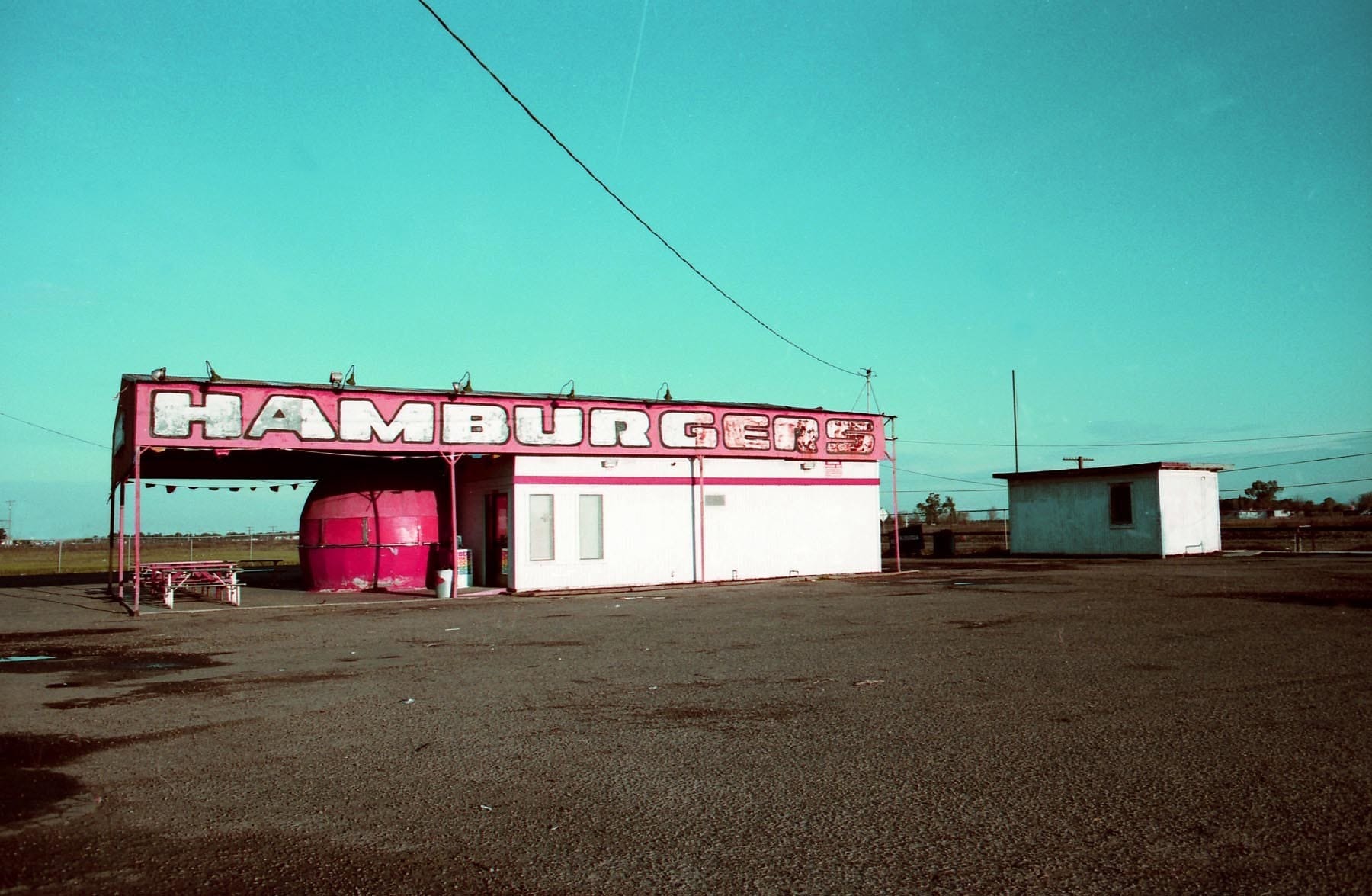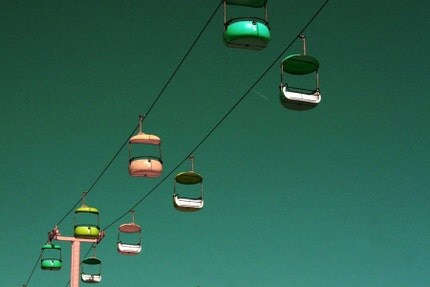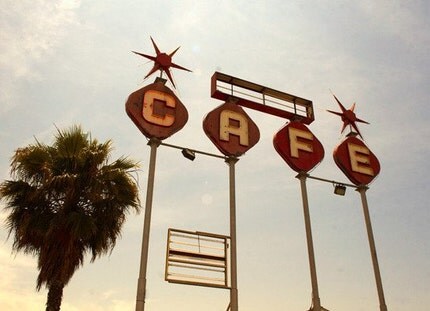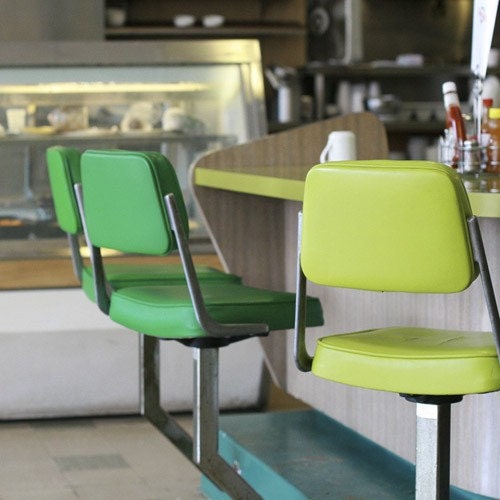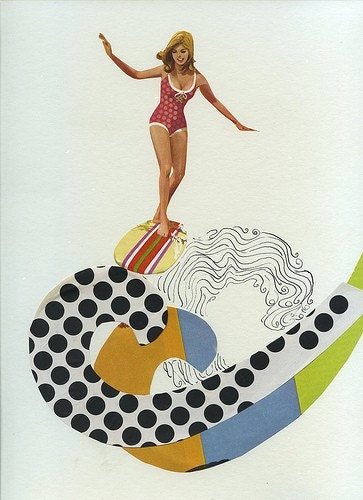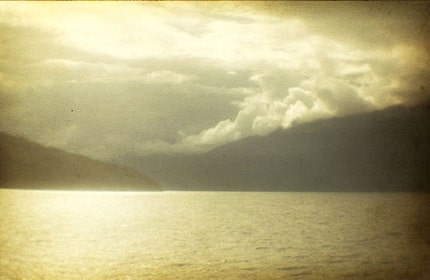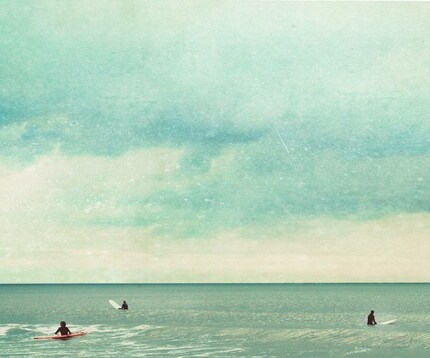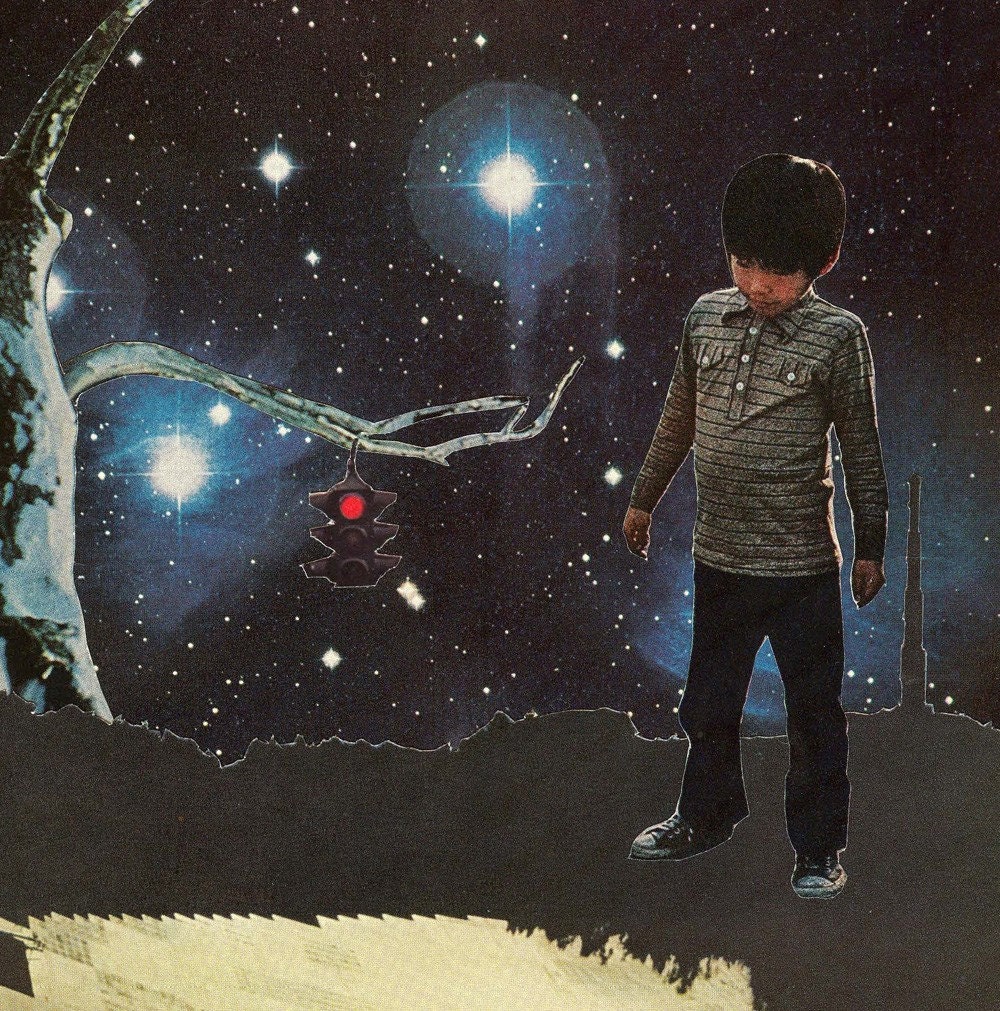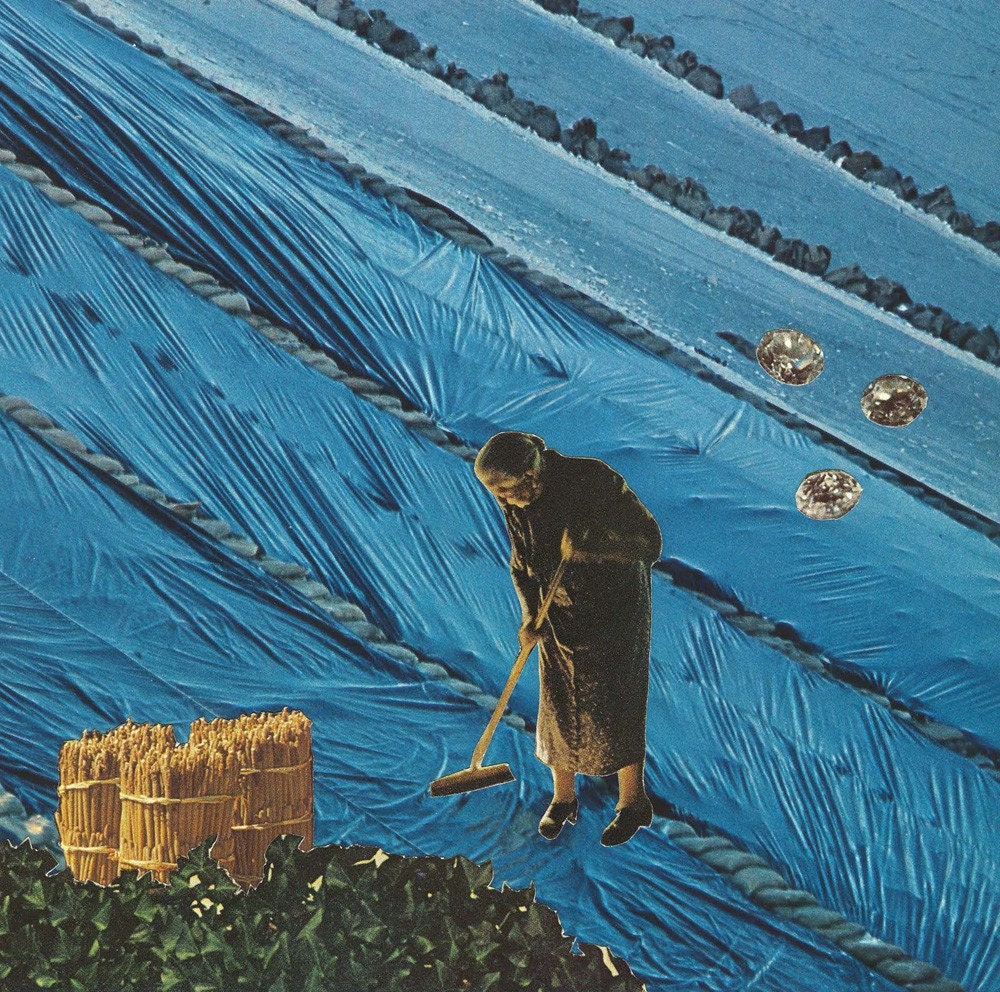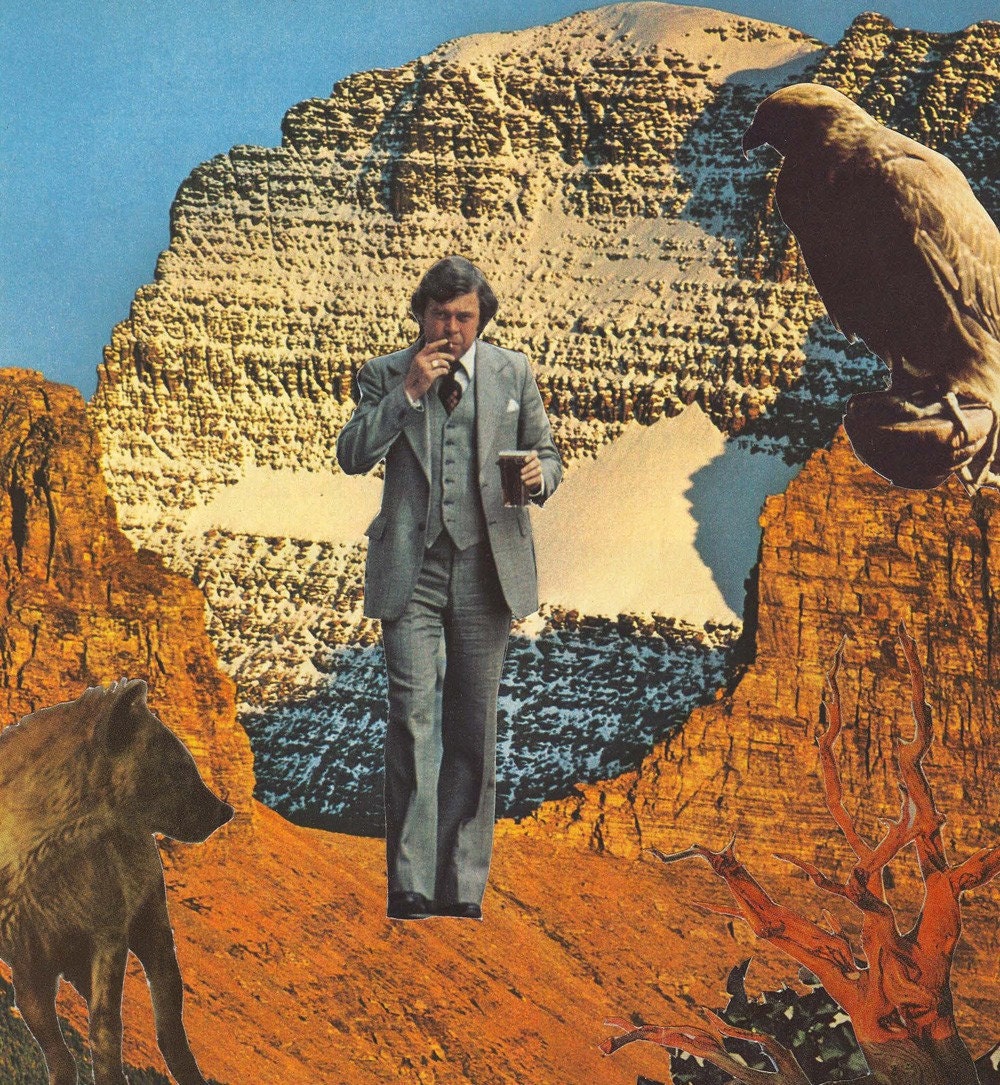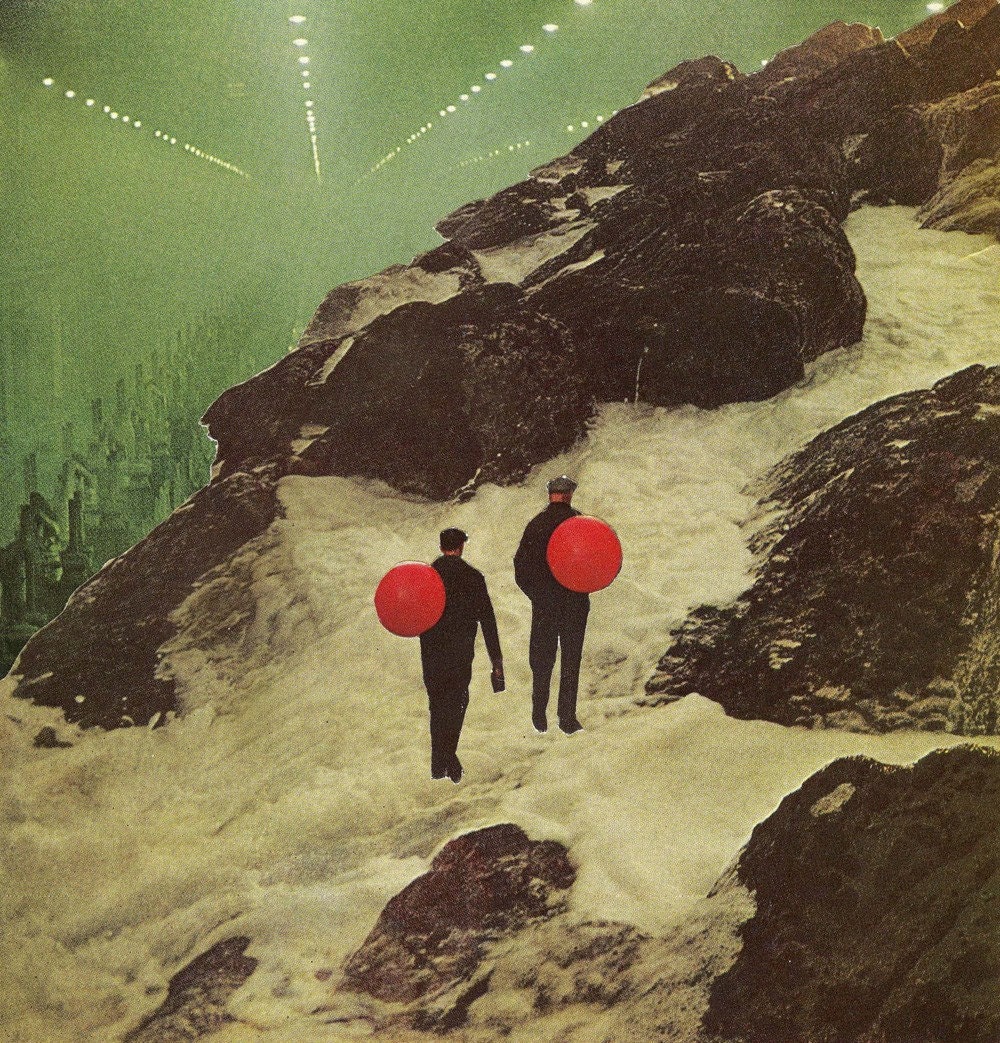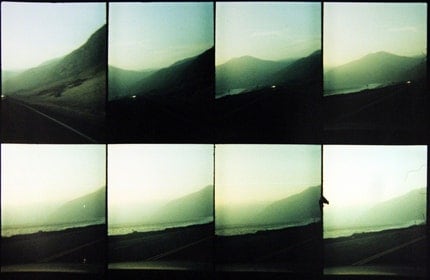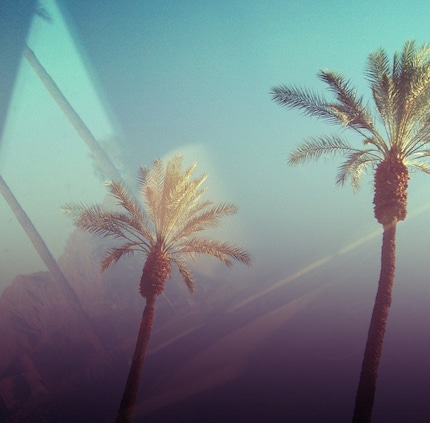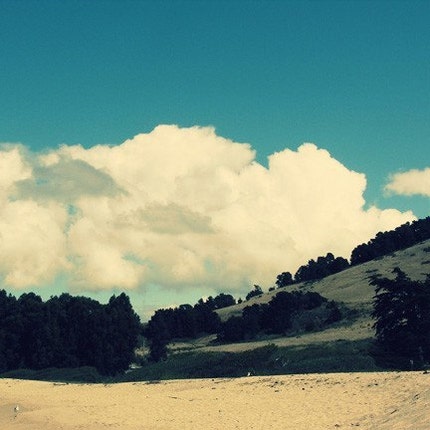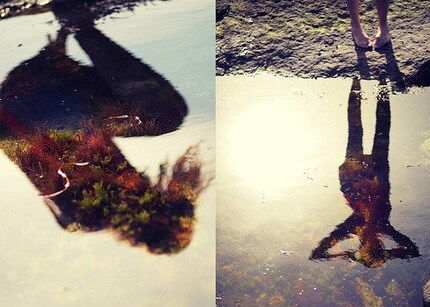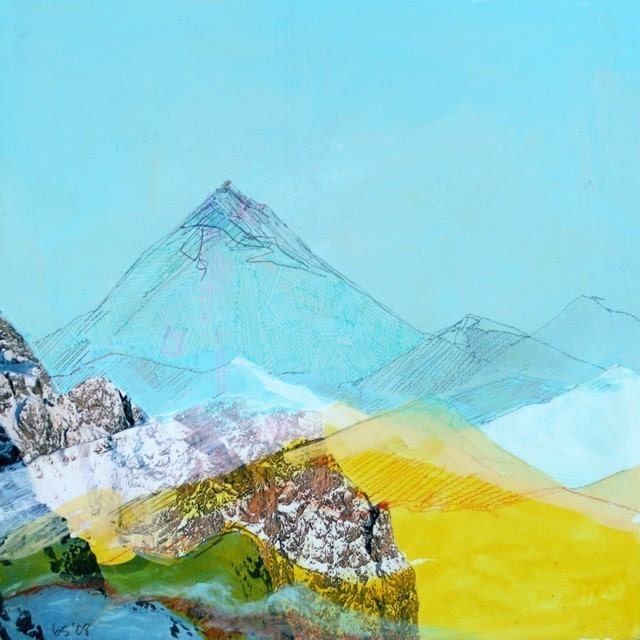Thursday, July 30, 2009
Jen Zahigian - Featured Artist
Photographer Jen Zahigian, a resident of Oakland, California’s Waterfront District, has a relationship with photography that dates back to her childhood when her grandfather introduced her to the art. Her personal history informs her work, as does the mid-twentieth century history of California’s popular roadside attractions and establishments. While Zahigian’s photographs are a document of sites that have long held her appreciation for their aesthetic appeal and their place in her memory, they also express a philosophical position associated with the mid to late twentieth century American landscape of the road.
Many of Zahigian’s photographs depict California highway establishments and their signage. She frequently takes as her subjects such places as diners, motels and convenience stores. Clearly Zahigian has an appreciation for their dated aesthetic, with their patina of rust and neglect. Some of these subjects are sites from her youth, such as the desolate hamburger stand in “Mammoth Orange,” and the interior of “Pot Pie Shop.” Frequently, her photographs are composed to present only bits of information. Yet there is always enough that the results are deeply evocative, employing an economical and stately formalism.
Because many of Zahigian’s photographs are related explicitly and implicitly to the road and travel, they bear a bittersweet sense of impermanence and transience. Zahigian’s subject matter speaks to a sense of nostalgia for an American landscape that rushes past the windshield during a journey away, or back home.
A distinctly American brand of existentialism is evident through the tone, composition, and subject matter of Zahigian’s photographs. This lonesome highway existentialism is typified by such New Hollywood road movies as Dennis Hopper’s “Easy Rider” (1969), and in particular Monte Hellman’s “Two Lane Blacktop” (1971). Many of Zahigian’s photos could almost be stills from “Two Lane Blacktop,” a film marked by quietude and a foreboding sense of alienation.
Jen Zahigian’s camera searches for and selects meaning from historical roadside monuments—monuments to travel, transience, and movement. The viewer is put in the position of the existential wanderer, making meaning from the associations they draw individually from her photographs.
Jen Zahigian’s photographs are exhibited extensively in many galleries and boutiques in the Bay Area, and have been exhibited at SFMOMA. Her photographs can also be seen on-line at these sites:
www.jenzahigian.com
Roadside Photographs on Etsy
That Wondrous Time - Blog
Labels:
Featured Artists,
Trees

Wednesday, July 29, 2009
Just Say No, Not 'til After Work.
I don’t hear it very often these days, but in the late 1960’s and early 1970’s, back when marijuana had seeds in it, an ounce of the stuff was referred to as a “lid.” A lid is also a slang term for a hat.
To which type of lid Sid and Marty Krofft were referring with their show Lidsville is the fuel for much tongue in cheek speculation. Lidsville is as jarringly bizarre, psychedelic and colorful as any Sid and Marty Krofft production, true enough. However, within the work there is no evidence that Lidsville refers to marijuana or any other psychedelic chemical compound.
Sid and Marty Krofft, do not deny that they may have taken psychedelic drugs in the 1960’s and ‘70’s, but they have always vehemently denied that they were under the influence of drugs during the production of their shows and that their shows were influenced by or indicative of a drug experience. When we give Sid and Marty the benefit of the doubt, or better yet, throw the whole issue out entirely, Lidsville is even more fantastic and complex.

To suggest that there is a prior drug experience and language system (drug slang) that provides the basis for Lidsville is to diminish, and marginalize a surreal and unique text. Such an interpretation looks outside of the text for meaning and reduces Lidsville to a mere symbol system, and a not-so-subtle inside joke. Dealt with on its own terms Lidsville is a highly (pun intended) imaginative product of much hard physical and creative work. Lidsville doesn’t have to be a code, like your tax return or something, it can be so much more.
I will concede that drugs do provide an apt simile for the experience of watching Lidsville in that it’s like good, clean acid—a little goes a long way, and you’ll never be the same once it's over.
To which type of lid Sid and Marty Krofft were referring with their show Lidsville is the fuel for much tongue in cheek speculation. Lidsville is as jarringly bizarre, psychedelic and colorful as any Sid and Marty Krofft production, true enough. However, within the work there is no evidence that Lidsville refers to marijuana or any other psychedelic chemical compound.
Sid and Marty Krofft, do not deny that they may have taken psychedelic drugs in the 1960’s and ‘70’s, but they have always vehemently denied that they were under the influence of drugs during the production of their shows and that their shows were influenced by or indicative of a drug experience. When we give Sid and Marty the benefit of the doubt, or better yet, throw the whole issue out entirely, Lidsville is even more fantastic and complex.

To suggest that there is a prior drug experience and language system (drug slang) that provides the basis for Lidsville is to diminish, and marginalize a surreal and unique text. Such an interpretation looks outside of the text for meaning and reduces Lidsville to a mere symbol system, and a not-so-subtle inside joke. Dealt with on its own terms Lidsville is a highly (pun intended) imaginative product of much hard physical and creative work. Lidsville doesn’t have to be a code, like your tax return or something, it can be so much more.
I will concede that drugs do provide an apt simile for the experience of watching Lidsville in that it’s like good, clean acid—a little goes a long way, and you’ll never be the same once it's over.
Tuesday, July 28, 2009
Now I've Gone Away
As Trees recently noted, we are living in a 'post-Stamos' era. Anyone over 25 will surely remember Jesse and the Rippers and their soulless cover of "Forever" by The Beach Boys. Unfortunately, for many, seeing the song performed on Full House may have been their first exposure to what is arguably one of the best Beach Boys songs not written by Brian Wilson. I don't blame Stamos especially. If given the chance it would be hard to say no to performing with any Beach Boys incarnation. Let's just say we forgive and truly, finally, forget.
Labels:
Bees,
Featurettes,
Music

Saturday, July 25, 2009
MacArthur Starship
"While Riley slept, they downloaded the history of humanity, alien insights, and a mass of knowledge into his memory"...
"We deal now, not with things of this world alone, but with the illimitable distances and as yet unfathomed mysteries of the universe. We are reaching out for a new and boundless frontier. We speak in strange terms of harnessing the cosmic energy...of spaceships to the moon...of ultimate conflict between a united human race and the sinister forces of some other planetary galaxy; of such dreams and fantasies as to make life the most exciting of all times." - General MacArthur's Thayer Award Speech -- Duty, Honor, Country (1962)
Thursday, July 23, 2009
Tracy Jager – Featured Artist
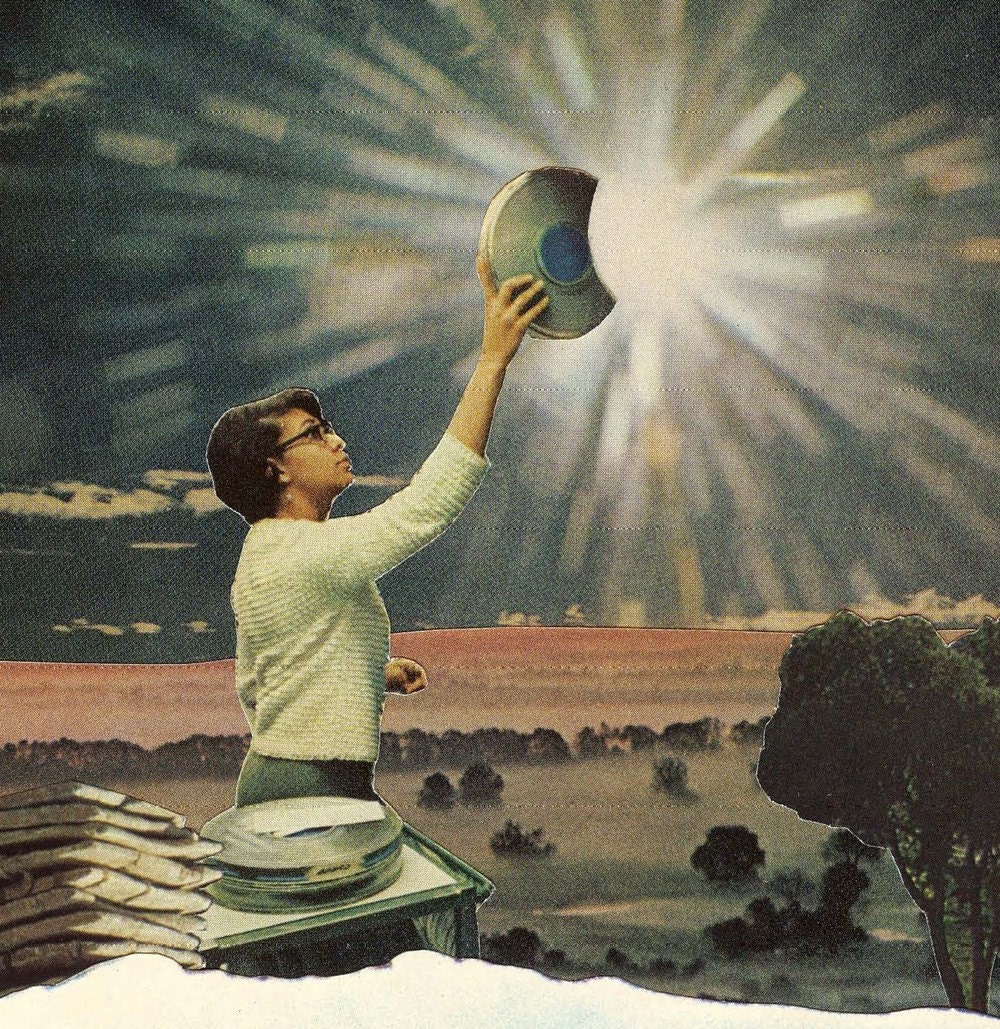
Tracy Jager, the fifth stage of sleep, 8X8in., Collage
Vancouver based artist Tracy Jager makes collages that are rich with poetic ambiguity. Using imagery from the 1960’s and 70’s, her collages draw from historical and contemporary realist art movements. Themes of work/activity, human relationship with the environment and transportation, both literal and figurative, are apparent in her work.
Like the 1960’s collage work of Richard Hamilton, Jager’s collages frequently depict human figures in a naturalistic figure/ground relationship. Figures exist in more or less sensible spatial relationship to one another within the pictorial environment. The pictorial environment, a conflation of landscape images recombined with elegant formal cohesion, create a dream-like context for the figures within. The figures are often engaged in some type of work or activity rendered indistinct by their strange surroundings.
There is a preponderance of pronouns in Jager’s titles suggesting that the depicted figures are her subjects with whom she wishes the viewer to identify. Perhaps the surrealism of the landscape is a result of the work enacted by Jager’s subjects, or perhaps in spite of it. Still a more interesting notion supported by the work is that the landscape is reflective of the mental states of the subjects brought on by an involvement with their activities. A strength of Jager’s collages is that they pose more questions than they seek to answer.
Similar to the figures in the paintings of Neo Rauch, who are also involved in some ambiguous yet seemingly purposeful endeavor, Jager’s subjects seem at ease within the disjuncture around them. That Jager utilizes images from the 1960’s and 70’s further distances the subjects of her work from contemporary reality. As with Rauch, this retro feel harkens to social realism, though the connection is less overt than in Rauch’s work.
Various modes of transportation are presented in the collages. Cars, trucks and boats assume the same naturalistic figure/ground relationship as the subjects of the work. These vehicles could refer literally to travel and work, or more likely they function on a metaphorical level and refer to a movement of the mind.
Tracy Jager’s collages can bear many satisfying interpretations, from a purely formal read to the more allegorical. Whatever other interpretation, the collages all seem to allude to Karma Yoga, or a state of transcendence brought on by total immersion in an activity for the sake of itself.
See more collages in Tracy's shop living feral.
Labels:
Featured Artists,
Trees

Tuesday, July 21, 2009
It Never Rains in Southern California
Trees and I have a bit of a thing for the West Coast, and I guess today the beach is more on my mind than usual. I think these images capture some of the calm tranquility of my fantasy California.
bright new things
Mariah Gale
It Never Rains In Southern California - Albert Hammond
bright new things
Mariah Gale
Labels:
Bees,
Featurettes

Monday, July 20, 2009
Pop Portraiture (and a Chimp in Hippie Garb)
Much of my work draws from popular culture as its source, but I don’t think about Pop Art all that much. However, it was on my mind a lot in making two very different portraits—one of Ronnie Spector, and one of a chimpanzee. I painted the portraits in gouache, my second favorite paint, as a stop-gap project between oil paintings. The two portraits represent variant relationships to Pop Art.
I used a common photograph of Ronnie Spector as the source for my portrait of her. The source material is already an iconic and pre-coded sign that stands for Ronnie Spector. I painted that sign as a monochrome further flattening the image and aligning it with the strain of Pop Art that most closely resembles mass-produced, utilitarian images and artifacts. The border of the portrait I lifted from Peter Blake’s 1968 work, “Rainbow Babe.”
I used a common photograph of Ronnie Spector as the source for my portrait of her. The source material is already an iconic and pre-coded sign that stands for Ronnie Spector. I painted that sign as a monochrome further flattening the image and aligning it with the strain of Pop Art that most closely resembles mass-produced, utilitarian images and artifacts. The border of the portrait I lifted from Peter Blake’s 1968 work, “Rainbow Babe.”
| Though derived from popular culture, the portrait of the chimp is more photo-based realism than Pop Art, per se, and is more in keeping with my usual way of working. The source of the portrait is Lancelot Link, Secret Chimp. My technical decisions in the painting were based upon situating the chimp in space and representing it in a naturalistic way. The chimp here is elevated to iconic status though it didn’t start out that way. At least, not in the same way as Ronnie Spector. |  Untitled, Gouache on paper, 12x9in., 2009 |
Friday, July 17, 2009
High Desert
I might be a little slow on the draw, but I just found out about Neil Krug and his collaboration with girlfriend Joni Harbeck. It seems they've been spending their time out in the desert taking gorgeous photos and no one bothered to tell me about it. These images satisfy everything I want from a photograph. They're beautifully composed, the subject matter is 70's pulp (that's not a necessity for me, but it helps), and the colors are stunning. Washed out, low contrast color has become the latest craze (polaroid anyone?), but these instant gems really take it a step further. When was the last time you stripped down to nothing but your headdress for a photo shoot?




All Photographs taken by Neil Krug
See the collaboration site here - Pulp Art Book
And his fab flickr here - Neil Krug on flickr




All Photographs taken by Neil Krug
See the collaboration site here - Pulp Art Book
And his fab flickr here - Neil Krug on flickr
Labels:
Bees,
Featurettes

Thursday, July 16, 2009
Erik Groff - Featured Artist
“I really like presenting in the studio/lab, with paint on the walls, and the mess. To me that’s the best and most real part of the painting’s life, before it is put to rest with a signature and potentially just crated away and forgotten.” –Erik Groff
| Erik Groff is a multi-media artist whose work ranges from two-dimensional pieces to installations, the sites of which might be a pristine gallery space, a vacant lot or a clogged street in midtown Manhattan. Regardless of media or venue, Groff’s creativity, and the artwork born of it, contain a sense of exploration with boundary. |
| Groff’s abstract paintings exemplify his affection for the process of art making. However, his process never overshadows the highly aesthetic products he creates. Working out of the tradition of abstract expressionism, Groff’s paintings are an affirmation of the painted surface as the highest reality of the work. There is no spatial illusion, narrative or allegory. A clear antecedent of Groff’s work are the paintings of Willem DeKooning, due in part to the formal cohesion achieved through an emphasis on line. |
|
Labels:
Featured Artists,
Trees

Tuesday, July 14, 2009
Friday, July 10, 2009
Evolution Revolution
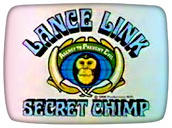 I’m not afraid to lay it right on the line. I think Lancelot Link, Secret Chimp is funny. Really, really funny. Chimps in clothes, acting human is right up my alley, especially when the whole routine bangs and clangs with the color and noise of early 1970’s, Saturday morning psychedelia.
I’m not afraid to lay it right on the line. I think Lancelot Link, Secret Chimp is funny. Really, really funny. Chimps in clothes, acting human is right up my alley, especially when the whole routine bangs and clangs with the color and noise of early 1970’s, Saturday morning psychedelia.I decided to indulge this sophomoric side of my self with a painting of the Evolution Revolution, the “band” of chimps that occasionally “performed” on Lancelot Link, Secret Chimp. I thought I might write something about how these chimps seem to display the three or four most primitive neurological circuits of the brain, as described by Dr. Timothy Leary, and what that says about being/seeming human. However, none of that stuff quite captured the spirit of the Evolution Revolution or my painting of them.

Evolution Revolution, Oil on Canvas, 32 x 42in. 2009
I made this painting in a spirit of fun, humor and adventure. While speaking to my obsession with the late 1960’s-early 1970’s media of Los Angeles, the painting represents a departure from my typical way of working in a few key respects. The palette is about twice the size of that with which I generally work. There are fourteen individual colors represented, not including white and the earth-colors I used for the under-painting. I typically paint with round brushes of varying sizes, but for “Evolution Revolution” I used only one size 12, (which is pretty big), flat brush. Also, I did a lot of painting with my left hand—I am right-handed.
Just for kicks, enjoy this video of the Evolution Revolution doing their thing. The keyboard player particularly tears things up! And you can leave the bong on the shelf. This is joyous, hilarious and confusing enough just as it is.
Wednesday, July 8, 2009
Bryan Jones – Featured Artist
| Jones’ work celebrates the ability of painting to create a world unto itself. That painted world may have a referent in the physical world, as in the paintings of Rembrandt Van Rijn, with whose work Jones’ frequently shares technical and formal properties, or the painted world may have a metaphysical, abstract referent. Such is the case in the mature work of Jackson Pollock, of which Jones’ decentralized compositions are also reminiscent. |  Bryan Jones - Portrait, Oil on Linen over Wood, 28x24 in., 2009 |
Visit Bryan Jones' Site
Labels:
Featured Artists,
Trees

Tuesday, July 7, 2009
Friday, July 3, 2009
Brian Wilson- There and Everywhere
“Southern California,” from the 2008 album That Lucky Old Sun is distinctly a Brian Wilson composition. The lilting melody, and the careful, delicate arrangement bear the imprint of his best songs. Striking to me is the maturity both in the sound of Wilson’s voice and the perspective from which the song is written. “In My Room,” Wilson’s 1963 ballad with the Beach Boys, provides a yardstick by which to measure this maturity.

In “In My Room” the young Wilson sings of his bedroom as being a place where the pain and fear of consensual reality are blocked out in favor of a world of dreams and comfort. Both “In My Room” and “Southern California” use a single, specific location as a point of opening out into a broader metaphysical realm. For the young Brian Wilson it is his bedroom, for the older man it is the entire southern California region. “When you wake up there, you wake up everywhere,” he sings.

In “In My Room” the young Wilson sings of his bedroom as being a place where the pain and fear of consensual reality are blocked out in favor of a world of dreams and comfort. Both “In My Room” and “Southern California” use a single, specific location as a point of opening out into a broader metaphysical realm. For the young Brian Wilson it is his bedroom, for the older man it is the entire southern California region. “When you wake up there, you wake up everywhere,” he sings.
Thursday, July 2, 2009
Siempre la Luna - Blog/Home Boy Shout Out
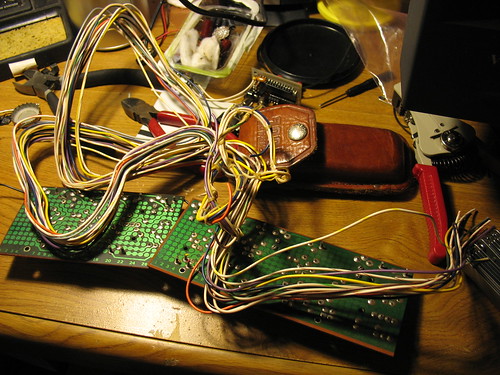
There’s a strange wind blowing out of Portland, Oregon. It carries the ominous sound of Slayer riffs and the smell of six year old pizza. I’m all a-flutter. I have reconnected with my friend Justin.
Justin is web-master of the blog Siempre la Luna, on which he recently gave Bees and Trees a most complimentary shout out. With peerless wit and insight Siempre la Luna covers robots, Japanese junk food, heavy metal thunder and disc golf—and that is just skimming the surface.
There are more hours in Justin’s day than yours or mine, and he doesn’t sleep. He is a lighting technician, self-proclaimed I.T. superhero, guitar virtuoso, composer, disc golf champion and wordsmith. All of his projects have the volume turned up to eleven and a built-in-the-basement, mad scientist singularity of vision.
Grab your shades, (because you’re gonna need ‘em), and go get inspired.
Labels:
Trees

Subscribe to:
Posts (Atom)

